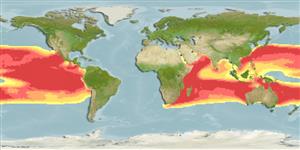Classificação / Names
Common names from other countries
Referência principal
Tamanho / Peso / Idade
Max length : 348 cm FL macho/indeterminado; (Ref. 40637); common length : 270 cm TL macho/indeterminado; (Ref. 9308); Peso máx. publicado: 100.2 kg (Ref. 40637); Idade máx. registada: 13 anos (Ref. 53742)
Ambiente
; marinhas; oceanódromo (Ref. 51243); intervalo de profundidade 0 - 200 m (Ref. 54238), usually 30 - ? m (Ref. 9688)
Clima / Intervalo
Subtropical, preferred 28°C (Ref. 107945); 50°N - 43°S, 16°E - 71°W (Ref. 43)
Distribuição
Indo-Pacific: tropical and temperate waters approximately 45°- 50°N and 40°-35°S in the western Pacific, 35°N and 35°S in the eastern Pacific; 45°S in western Indian Ocean and 35°S in eastern Indian Ocean. Entered Mediterranean Sea from Red sea via Suez Canal. Highly migratory species, Annex I of the 1982 Convention on the Law of the Sea (Ref. 26139). Some authors recognize a single worldwide species, Istiophorus platypterus (Shaw & Nodder 1792) but we follow Nakamura 1990 (Ref. 10820) retaining the usage of Istiophorus platypterus for the Indo-Pacific sailfish and Istiophorus albicans for the Atlantic sailfish in recognition of the differences between them.
Países | Áreas FAO | Ecossistemas | Ocorrências | Introduções
Descrição breve
Espinhos dorsais (total): 0; Raios dorsais moles (total): 47-53; Espinhos anais 2; Raios anais moles: 12 - 15. Body elongate and compressed; upper jaw prolonged into a very long beak; two dorsal fins, the first very large and tail; pelvic fins narrow but very long, almost reaching anus, with 1 spine and 2 rays; body covered with small, embedded scales with 1 or 2 blunt points; back dark with about 20 bluish vertical bars; belly pale silver; membrane of first dorsal fin blue black with numerous dark spots (Ref. 55763). A slender billfish with a high, sail-like first dorsal fin (Ref. 26938).
Categoria na Lista Vermelha da IUCN (Ref. 115185)
Ameaça para o homem
Harmless
Utilização humana
Pescarias: espécies comerciais; peixe desportivo: sim
Mais informação
ReferênciasAquaculturaPerfil para aquaculturaEstirpesGenéticaFrequência dos alelosHereditariedadeDoençasProcessamentoMass conversion
Ferramentas
Relatórios especiais
Descarregue XML
Fontes da internet
Estimates of some properties based on models
Phylogenetic diversity index
PD50 = 0.7505 many relatives (e.g. carps) 0.5 - 2.0 few relatives (e.g. lungfishes)
Nível Trófico
4.5 ±0.3 se; Based on diet studies.
Resiliência
Baixo, tempo mínimo de duplicação da população 4,5 - 14 anos (rm=0.11; K=0.4-0.8; tmax=13)
Vulnerabilidade
High to very high vulnerability (68 of 100)
Categoria de preço
